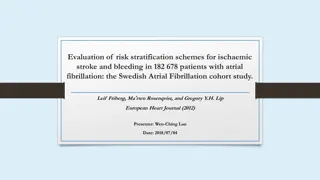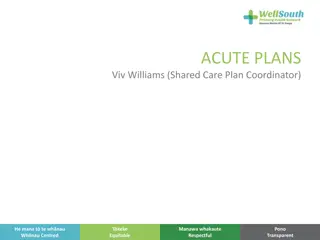Treatment of Acute malnutrition using Simplified Approaches.
Simplified approaches in the treatment of acute malnutrition involve modifications to existing protocols to optimize effectiveness, quality, and cost-efficiency. These approaches include family MUAC screening, CHW-led treatment, reduced follow-up visits, expanded admission criteria, single treatment
1 views • 15 slides
Automated CT Perfusion Imaging in Acute Ischemic Stroke: Overview
This presentation delves into the significance of automated CT perfusion imaging in diagnosing and treating acute ischemic stroke. It covers essential information such as the burden of stroke in Ontario, the critical aspect of time in stroke treatment, hyperacute stroke treatment goals, and the impo
4 views • 41 slides
Strategies to Address Acute Malnutrition and High Mortality Rates in Children Under 5
Malnutrition in children under 5, specifically acute malnutrition, is a pressing issue in the Western Cape. This presentation outlines the current strategies, multisector engagement, causes, and impacts of acute malnutrition. It delves into the classifications of malnutrition, including severe and m
1 views • 38 slides
National Stroke Audit Acute Services 2023 Hospital Data Slide Deck
Create an interactive slide deck using your hospital's data from the National Stroke Audit Acute Services 2023. Tailor the deck to suit your requirements by populating slides with your Framework and Clinical Care Indicator results. The deck is designed for sharing with your team and stakeholders. Ut
0 views • 15 slides
SISTER Study: Improving Stroke Treatment Response with TS23
SISTER Study led by Eva Mistry aims to identify a safe and effective dose of TS23 for treating ischemic stroke patients with core-penumbra mismatch. The Phase-2 trial involves 300 adults and spans 54 months, with primary endpoints focusing on treatment efficacy and safety. The study is randomized, p
0 views • 22 slides
Fitness and Exercise After Stroke: Importance and Guidelines
Understanding the importance of fitness and exercise in stroke recovery is crucial due to the varied challenges individuals face post-stroke. This toolkit provides information on the impact of stroke, the benefits of exercise, types of exercises recommended, and different exercise program options av
2 views • 11 slides
Hospital Stroke Care Audit 2023 Presentation
Customize your hospital's stroke care audit presentation using the provided template. Add your hospital's data to create an interactive slide deck for sharing with your team and stakeholders. The National Stroke Audit Acute Services 2023 focuses on assessing resources and clinical care indicators ag
23 views • 15 slides
Overview of Acute Cholecystitis: Diagnosis, Severity Grading, and Treatment
Acute calculous cholecystitis is a common digestive disease with varying treatment perspectives. The Tokyo Guidelines 2018 provide criteria and severity grading for the diagnosis of acute cholecystitis. Diagnosis involves local and systemic signs of inflammation along with specific imaging findings.
0 views • 18 slides
Clinical Update: 2021 AHA/ASA Guideline for Stroke Prevention
This clinical update provides guidance adapted from the 2021 AHA/ASA Guideline for the Prevention of Stroke in Patients with Stroke and Transient Ischemic Attack. It categorizes recommendations based on strength and quality of evidence, outlining levels of recommendation and evidence for different c
0 views • 43 slides
Comprehensive Guide to Stroke Care: SCENS Protocol Overview
This comprehensive guide delves into the SCENS protocol for stroke care, covering learning objectives, reasons for implementation, major stroke types, risk factors, the 8 Ds of stroke care, important time goals, and the FAST assessment process. It emphasizes the importance of early detection, swift
3 views • 20 slides
Understanding Leukemia: Causes, Types, and Treatment Options
Leukemia is a group of blood disorders characterized by abnormal white blood cell production. Factors like genetics, environment, and mutations in DNA play a role in its development. Acute leukemia requires urgent treatment due to rapid cell growth, while chronic leukemia progresses more slowly. The
1 views • 20 slides
Comprehensive Stroke Program Orientation for Medical Staff - Facts and Objectives
The Comprehensive Stroke Program provides crucial information for medical staff, covering acute stroke response, available stroke codes, and responsibilities during inpatient care. Stroke facts highlight the prevalence, causes, risk factors, and complications associated with strokes. Details on lacu
0 views • 22 slides
Global Nutrition Prevalence Rates in Children and Women
This content highlights the prevalence rates of acute malnutrition, severe acute malnutrition (SAM), moderate acute malnutrition (MAM), childhood stunting, acute malnutrition based on MUAC and edema, and acute malnutrition in pregnant and lactating women. The data is based on various criteria such a
9 views • 37 slides
Understanding Inflammation and Its Characteristics
Inflammation is the response of tissues to harmful agents, categorized as acute or chronic. Acute inflammation is rapid and short-lived, while chronic inflammation is insidious and prolonged. Chemical mediators play a crucial role in both forms, leading to tissue necrosis. The five cardinal signs of
3 views • 27 slides
Comprehensive Overview of Acute Abdomen Assessment and Management
This detailed guide covers the definition, general approach, history taking, physical examination, investigations, diagnosis, and management of acute abdomen cases. Learn about common causes, such as acute appendicitis, bowel obstruction, and medical conditions. Real-life scenarios illustrate differ
2 views • 15 slides
Advanced Treatment Processes for Faecal Sludge Management
Treatment processes for faecal sludge management involve various stages including preliminary treatment, primary treatment, secondary treatment, and tertiary treatment. Each stage employs mechanical, biological, and chemical processes to separate, decompose, and remove contaminants from the sludge,
0 views • 7 slides
National Stroke Audit Acute Services 2023 Hospital Data Presentation
Tailor and present your hospital's data from the National Stroke Audit Acute Services 2023 with an interactive slide deck. Utilize the provided template to display and share results focusing on the Organisational Survey and Clinical Care Indicators. Enhance your presentation by transposing hospital
0 views • 15 slides
Inpatient Management of Severe Acute Malnutrition Training Course 2011
This training course focuses on inpatient management of severe acute malnutrition, teaching procedures outlined in the national Community-Based Management of Severe Acute Malnutrition Guidelines. The training aims to reduce case fatality rates significantly and is designed for physicians, senior nur
0 views • 9 slides
Acute Malnutrition - Fluid Management and Treatment Overview
Acute malnutrition, particularly severe acute malnutrition (SAM), requires careful fluid management and a structured treatment approach involving stabilization, transition, and rehabilitation phases. This condition results from inadequate dietary intake or acute infections, leading to severe wasting
0 views • 23 slides
Stroke Smart Medical Practice - Empowering Awareness and Early Intervention
Discover the Stroke Smart Medical Practice initiative aimed at enhancing stroke awareness, recognizing signs, and ensuring timely intervention. Uncover key statistics, warning signs, treatment predicaments, and the history behind this vital program. Join the movement to educate patients and medical
0 views • 17 slides
Comprehensive Treatment Guidelines for Acute Ischemic Stroke
In the management of acute ischemic stroke, the primary goals are to reduce secondary brain damage, maintain adequate perfusion, and prevent recurrent strokes by managing risk factors. Treatment includes maintaining tissue oxygenation, correcting volume status and electrolytes, managing blood glucos
0 views • 20 slides
Comprehensive Approach to Enhancing Stroke Treatment Response
Enhance stroke treatment response by focusing on strategies, training, contacts, learning goals, and processes. Understand the screening criteria, consent process, inclusion criteria, and steps for site readiness. Key contacts for project management and training are provided for a successful stroke
0 views • 52 slides
Stroke Association Campaign: Driving Change for Stroke Awareness
The Stroke Association's campaign aimed to raise awareness and lobby the government for a new stroke strategy. Through strategic communication efforts, including petitions, media engagement, and famous landmarks turning purple, the campaign successfully reached key audiences, gained petition signatu
0 views • 5 slides
Understanding Stroke-Specific Etiologies and Interventions for Falls in Inpatient Rehabilitation
Falls are a common complication after stroke, leading to hip fractures and various secondary complications. Inpatient rehabilitation often focuses on interventions to reduce stroke-related falls, considering factors like muscle tone, cognitive impairments, and balance deficits. Understanding these s
1 views • 27 slides
Impact of Extending Acute Stroke Triage Criteria to 24 Hours
Landmark trials have extended the therapeutic time window for mechanical thrombectomy for acute ischemic stroke patients. This study evaluates the impact of implementing a protocol change to extend the time window at a comprehensive stroke center. Retrospective analysis compared stroke alerts and ke
1 views • 8 slides
Ticagrelor Added to Aspirin in Acute Non-Severe Ischemic Stroke or TIA of Atherosclerotic Origin
Among patients with transient ischemic attack (TIA) or minor ischemic strokes, adding ticagrelor to aspirin has shown superior efficacy in preventing stroke or death, particularly in those with ipsilateral atherosclerotic stenosis. The THALES trial demonstrated that ticagrelor added to aspirin was m
0 views • 14 slides
Treatment Strategies for Hemorrhagic Stroke: Goals and Management
Short-term goals for treating hemorrhagic stroke involve rapid neurointensive care to maintain adequate oxygenation, breathing, and circulation, along with managing increased intracranial pressure and blood pressure. Long-term management focuses on preventing complications, recurrent bleeding, delay
11 views • 9 slides
Advances in Anticoagulation Therapy for Cancer-Related VTE and Stroke
Recent studies have shown advancements in anticoagulation therapy for cancer patients with venous thromboembolism (VTE) and stroke prevention. Direct oral anticoagulants (DOACs) are now considered beneficial for treating VTE in cancer, offering advantages in administration and efficacy. Different an
3 views • 9 slides
Evaluation of Risk Stratification Schemes for Ischaemic Stroke and Bleeding in Atrial Fibrillation Patients
A study conducted in Sweden on 182,678 patients with atrial fibrillation aimed to investigate risk factors for stroke and bleeding. The research assessed the application of CHA2DS2-VASc and HAS-BLED schemes for stroke and bleeding risk evaluations. Data from the Swedish Atrial Fibrillation cohort st
0 views • 20 slides
Managing Eating and Swallowing Challenges After Stroke
Dysphagia, a common issue after a stroke, can lead to difficulty swallowing and may require texture modifications in food and fluids for safety. Up to 65% of stroke survivors may experience dysphagia, which can lead to complications like pneumonia. Proper oral care, mealtime positioning, and awarene
0 views • 9 slides
Understanding Abnormal Liver Function Tests: Acute vs. Chronic Approach
Comprehensive discussion on assessing patients with abnormal liver test results, focusing on distinguishing between acute and chronic liver conditions. Covers diagnostic workup, patient cases, and differential diagnosis, emphasizing the importance of patient history, physical examination, and key di
0 views • 16 slides
Stroke Recovery Peer Support Program Guidelines
Learn about the "Peers Fostering Hope Supported by the Dr. Ed & Bobby Yielding Fund for Stroke Recovery" initiative aiming to re-engage and re-integrate stroke survivors into the community. Explore how peer visitors provide support, encouragement, and hope for community re-engagement and reintegrati
1 views • 16 slides
Review of Care for Patients with Acute Bowel Obstruction: Recommendations and Key Findings
This review assesses the quality of care provided to patients aged over 16 years with acute bowel obstruction. Significant delays were identified in the care pathway, from imaging requests to availability of operating theatres. Recommendations include prompt CT scans with intravenous contrast for de
0 views • 32 slides
Comprehensive Guide to Creating and Understanding Acute Care Plans
This comprehensive guide provides detailed information on creating and understanding acute care plans, including the purpose of an acute plan, who needs one, what information can be written in an acute plan, examples of baseline clinical parameters, alerts to more detailed plans, and insights into c
0 views • 17 slides
Epidemiology of Hepatitis B and C in Florida: 2019 Data Analysis
The Department of Health in Florida has released the 2019 data on the epidemiology of Hepatitis B and C as of January 21, 2021. The report includes information on acute and chronic cases, technical notes on case definitions, and changes in national case definitions in 2020. Acute cases require speci
0 views • 35 slides
Enhancing Stroke Program Performance: ASRH Designation Site Visit Data & Improvement
Explore the data presentation template for an Acute Stroke Ready Hospital (ASRH) designation site visit, focusing on key metrics like door-to-activation times and imaging procedures. Evaluate trends, showcase improvements, and address future plans for quality enhancement. Consider additional trackin
0 views • 11 slides
Approach to Acute Flaccid Paralysis in Children: Evaluation and Management
Acute muscular weakness in children is a neurological emergency defined by sudden onset muscle weakness or paralysis in less than 5 days. When evaluating a child with acute flaccid paralysis, consider factors like onset rhythm, associated symptoms, and past medical history. A thorough physical and n
0 views • 45 slides
Children's Hospital @ Home: Acute Nursing Care in Tower Hamlets
Providing acute nursing care for children at home from 8 am to 10 pm, the Children's Hospital @ Home in Tower Hamlets offers services such as IVABs, NGT re-insertion, acute assessment, wheeze management, and home-based phototherapy. The initiative aims to reduce hospital stays, minimize admissions f
0 views • 7 slides
Emergency Medical Stroke Assessment (EMSA) Abnormal Signs & Evaluation
This comprehensive guide outlines the Emergency Medical Stroke Assessment (EMSA) protocol for assessing potential stroke patients. It covers the evaluation of abnormal signs related to eye movement, motor weaknesses in the face, arms, and legs, as well as slurred speech or aphasia. The assessment in
0 views • 9 slides
Stroke Continence Protocols for Managing Bladder and Bowel Function After Stroke
This protocol outlines the management of urinary and bowel incontinence in stroke patients, emphasizing high nursing care levels and avoiding unnecessary catheterization. It discusses normal bladder functions, urinary dysfunction prevalence post-stroke, and interventions for promoting continence. Ur
0 views • 30 slides







































